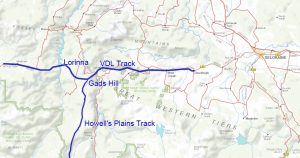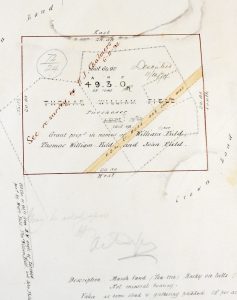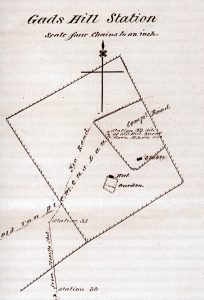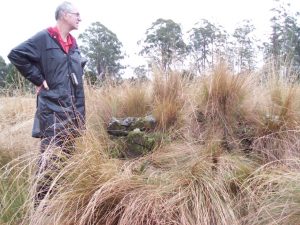In April 1842 a new settler named Frederick Wilbraham Ford, his future father-in-law Thomas King and four convict servants drove 75 cattle overland from Longford to King’s new property at Table Cape.1 This was an adventure. There were unbridged rivers to ford, including the smooth-stoned Mersey, along the Van Diemen’s Land Company (VDL Co) Track through the highlands. The track was also poorly graded and barely formed. Luckily the Mersey River was low on this occasion, but 2.5-hour ascent of Gads Hill was unnervingly steep. ‘The herding cattle kept herding back’, Ford wrote. ‘As they came back we had to shout, halloo, scream; rattling our sticks into their head, ears, noses, forcing them on …’

On top of the hill they met two men who were to build a hut ‘for a gentleman who had hired a vast tract of land as a cattle run’. The men warned Ford about the Mersey-Forth divide: ‘You may get hemmed in between the rivers for weeks without provisions—one or two have been starved to death here—the gentleman in question met the same adventure—so to avoid mistakes in future he has got a hut put up’.2
The ‘gentleman in question’ was William Field junior. The Field brothers—William (1816–90), Thomas (1817–81) John (1821–1900) and Charles (1826–57)—were extending their late father’s pastoral estate to the western side of the Mersey River. The Gads Hill Hut was built to house a stockman, not as a safety net, although any stranger would be welcomed in that isolated place.3 As well as being a high country cattle run, Gads Hill Station became a holding paddock for Field cattle being driven to or from stations further afield—their private leases at the Middlesex Plains, the Hampshire and Surrey Hills to the west; and Crown leases at the Borradaile Plains and Howells Plains to the south. It was the fulcrum of a grazing empire that, according to Thomas Field, once extended to the west coast.
Like their father, William Field senior (1774–1837), the Field brothers had a voracious appetite for pasture, and ruled by intimidation. They dominated their impoverished landlord, the VDL Co, increasing their power over that company as its fortunes declined. Divesting the Fields of VDL Co land once they were established on it was difficult, since few other graziers wanted such large, isolated holdings, and anyone who did take on the VDL Co holdings would first have to tackle Fields’ far-flung wild cattle. The Fields knew that legitimately occupying VDL Co and Crown land allowed them to illegitimately occupy all the adjoining open plains of the north-western highlands gratis.4
The 1862 survey, showing the position of the stable
and 1848 hut and garden, the ‘old road’ and the ‘new road’,
the horse paddock and the main paddock, as well as the track to Howells Plains.
The VDL Co had built a stockyard at Gads Hill—Emu Plains, as they called it—as a staging post for its highland stock drives.5 This was the blueprint for Fields’ Gads Hill Station, where William Field leased 2000 acres of Crown land.6 An 1862 survey of Gads Hill Station detailed a post-and-rail fenced paddock arranged on the intersection of the VDL Co Track and the track to Howells Plains. Inside the holding paddock were a hut and garden, plus a stable built inside a fenced inner (horse) paddock. The stable was built for the original 1842 stockman’s hut, which burnt down c1848.
The identity of that first stockman is not recorded. Thomas Shaw (c1842–1928)7 was ‘overseer’ at Gads Hill 1858–83, although overseer is a very fancy word for a sixteen-year-old highland labourer supping on kangaroo steamer and ‘badger’ stew.8 The Shaws and the Browns were great names in the Field family album. Tom Shaw’s six brothers, Harry (Henry) Shaw (c1839–1912),9 George (c1843–1885),10 Daniel (c1844–1910),11 John (c1845–1917)12 and Jim (c1846–1916)13 were also well-known Field stockriders, Harry being the last Field stockman resident at the Hampshire Hills.14 Tom’s son Mark Shaw (1875–1963) followed his father into Fields’ employ, one of his duties being to stock the Ration Tree on the eastern slope of Gads Hill. This was the supply depot for far-flung Field stockmen keen to supplement the diet laid out above.15

Percy Sorell’s survey (031375, Titles Office) of William, Thomas and John Field’s
49-acre purchase on Gads Hill, 1873, depicts another fenced paddock to the
West as well as the horse paddock.
(Left) Chimney butt in the tussock grass at Old Gads Hill Station (Ian Hayes photo). (Right) A hawthorn bush remaining from Old Gads Hill Station, perhaps planted as part of a windbreak. Nic Haygarth photo.
In 1873 surveyor Percy Sorell described the Old Station block as ‘marsh land’, and it seems an odd place to build a hut. Today there is no sign of the original hut site, but the outline of the stable, the later (c1848) hut and the fence lines are just discernible. There are few surface artefacts, with even the remnant stone chimney butts being overgrown.
Copyright Nic Haygarth 2020
[1] The VDL Co was founded in London to grow fine wool in Van Diemen’s Land. The company’s comparatively late arrival in that colony in 1826, when most of the best grazing land had been alienated, led it to choose land in the far north-west and the north-western back country. To connect its holdings to markets in Launceston, in 1827–28 the VDL Co cut a rough highland track between the Chudleigh area and the Surrey Hills near latter-day Waratah. Its Hampshire and Surrey Hills blocks proved too cold and exposed for wool growing, and the company fared so badly financially that in 1852 it withdrew all its stock and became an absentee landlord, letting all its holdings. Fields rented the VDL Co’s 10,000-acre Middlesex Plains block from 1840 at £400 per year, but such was the decline in VDL Co fortunes that in 1860 Fields let Middlesex, the Hampshire Hills and Surrey Hills—170,000 acres in all—for the same price of £400.
[2] Frederick Wilbraham Ford to his sisters in England, 4 May 1842, 1998MS50 (QVMAG).
[3] For Gads Hill Hut hospitality see, for example, JE Calder, Notes of a journey through parts of the Counties of Devon and Wellington, undertaken in 1865’, Tasmanian Times, 18 May 1867, p.4.
[4 See Nic Haygarth, ‘The Middlesex Station huts 1901–20, or the twilight years of Fields’ highland run’, http://nichaygarth.com/index.php/2016/11/11/the-middlesex-station-huts-1901-20-or-the-twilight-years-of-fields-highland-run/, accessed 1 February 2020.
[5] See Henry Hellyer’s ‘Camp Drought’ map, 1828, reproduced on the inside cover of CJ Binks, Explorers of western Tasmania, Mary Fisher Bookshop, Launceston, 1980.
[6] ‘Occupation of Crown lands’, Courier, 19 July 1844, p.4.
[7] As a 29-year-old stockrider he married farmer’s daughter Rosanna Miller at the Roman Catholic Church, Deloraine, on 10 May 1871, marriage record no.57/1871, registered at Deloraine, RGD37/1/30 (TAHO), https://librariestas.ent.sirsidynix.net.au/client/en_AU/names/search/results?qu=thomas&qu=shaw&qf=NI_INDEX%09Record+type%09Marriages%09Marriages, accessed 8 February 2020. His father was given as William Henry Shaw. For his death, see ‘Parkham’, Examiner, 30 July 1928, p.5.
[8] ‘Supreme Court, Hobart’, Launceston Examiner, 19 September 1885, p.3.
[9] As a 34-year-old stockkeeper, he married nineteen-year-old servant Bridget Summers at the Roman Catholic Church, Emu Bay, on 21 May 1873, marriage record no.385/1873, registered at Emu Bay, RGD37/1/32 (TAHO), https://librariestas.ent.sirsidynix.net.au/client/en_AU/names/search/results?qf=NI_INDEX%09Record+type%09Marriages%09Marriages&qu=henry&qu=shaw, accessed 7 February 2020; died during a Roman Catholic church service in Latrobe on 21 January 1912, aged 73, see ‘A Latrobe sensation’, North West Post, 22 January 1912, p.2.
[10] As a 27-year-old stockrider George Shaw married nineteen-year-old servant Mary MacNulty at the Roman Catholic Church, Deloraine, on 4 July 1870, marriage record no.50/1870, registered at Deloraine, RGD37/1/29 (TAHO), https://librariestas.ent.sirsidynix.net.au/client/en_AU/names/search/results?qu=george&qu=shaw&qf=NI_INDEX%09Record+type%09Marriages%09Marriages&isd=true, accessed 7 February 2020. He was an overseer at Westfield when he was killed by a train while apparently riding a horse down the railway line between Exton and Deloraine on his way home from the racecourse on 6 April 1885. See ‘Terrible fatal accident’, Tasmanian News, 7 April 1885, p.3.
[11] As a 24-year-old labourer he married 22-year-old Maria Miller at the Roman Catholic Church, Westbury, on 24 June 1868, marriage record no.634/1868, registered at Westbury, RGD37/1/27 (TAHO), https://librariestas.ent.sirsidynix.net.au/client/en_AU/names/search/results?qu=daniel&qu=shaw, accessed 7 February 2020. Died 21 December 1910. See ‘Beulah’, North Western Advocate and the Emu Bay Times, 28 December 1910, p.2; and ‘About people’, Examiner, 29 December 1910, p.5.
[12] Died 25 March 1917, aged 71, see ‘Personal’, Daily Telegraph, 26 March 1917, p.4 and 27 March 1917, p.4; ‘Deaths’, Examiner, 26 March 1917, p.1.
[13] A record exists for a James Shaw born to bricklayer Thomas Shaw and the illiterate Eliza Basham on 3 May 1846, birth record no.1245/1846, registered at Launceston, RGD33/1/23 (TAHO), https://librariestas.ent.sirsidynix.net.au/client/en_AU/names/search/detailnonmodal/ent:$002f$002fNAME_INDEXES$002f0$002fNAME_INDEXES:1107035/one?qu=james&qu=shaw&qf=NI_INDEX%09Record+type%09Births%09Births&qf=PUBDATE%09Year%091840-1847%091840-1847, accessed 7 February 2020. However, James Shaw’s supposed brother Thomas Shaw was the son of ex-convict William Henry Shaw. Twenty-five-year-old farmer James Shaw married 22-year-old servant Martha Alice Pearce by Presbyterian rites at Bowerbank, Deloraine, the house of Robert Bell, on 19 September 1871, marriage record no.51/1871, registered at Deloraine, RGD37/1/30 (TAHO), https://librariestas.ent.sirsidynix.net.au/client/en_AU/names/search/results?qu=james&qu=shaw&qf=NI_INDEX%09Record+type%09Marriages%09Marriages#, accessed 7 February 2020. Died December 1916, see ‘Agricola’, ‘Farm jottings’, North West Post, 19 December 1916, p.12.
[14] ‘Obituary: late Mr WH Bonney, Deloraine’, Advocate, 26 July 1935, p.2.
[15] Mark Shaw; quoted by Kerry Pink, ‘New chapter in Western Tiers story will be for all to read’, Advocate, 12 January 1963, p.11.



Hello.
It was wonderful to come across your blogs that mention the Shaw brothers/family. As Shaw is a common name, I had hit a brick wall chasing my 3G grandfather William Henry Shaw. One of your blogs mentions that William Field’s first stock rider is not known, but through your leads, I’ve found that the father William Shaw was his first stock rider and travelled with Field with his first cattle to stock the property after his purchase from Smith. So a multiple generation relationship between Shaws and Fields. I have a copy of Thomas’ marriage reg that mentions his father as William Henry, however I don’t have any information that connects William Henry to any Tas convict records. One trove mention of him with Field claims that William Shaw is originally a Sydney man. I’m hoping you can point me in the direction of William Henry Shaw’s convict status so I can further my research. Any suggestions how to go from here would be greatly appreciated. Looking forward to reading more of your posts. Cheers. Kath Duggan
Hi Kath, we are looking into this and will get back to you, Peter